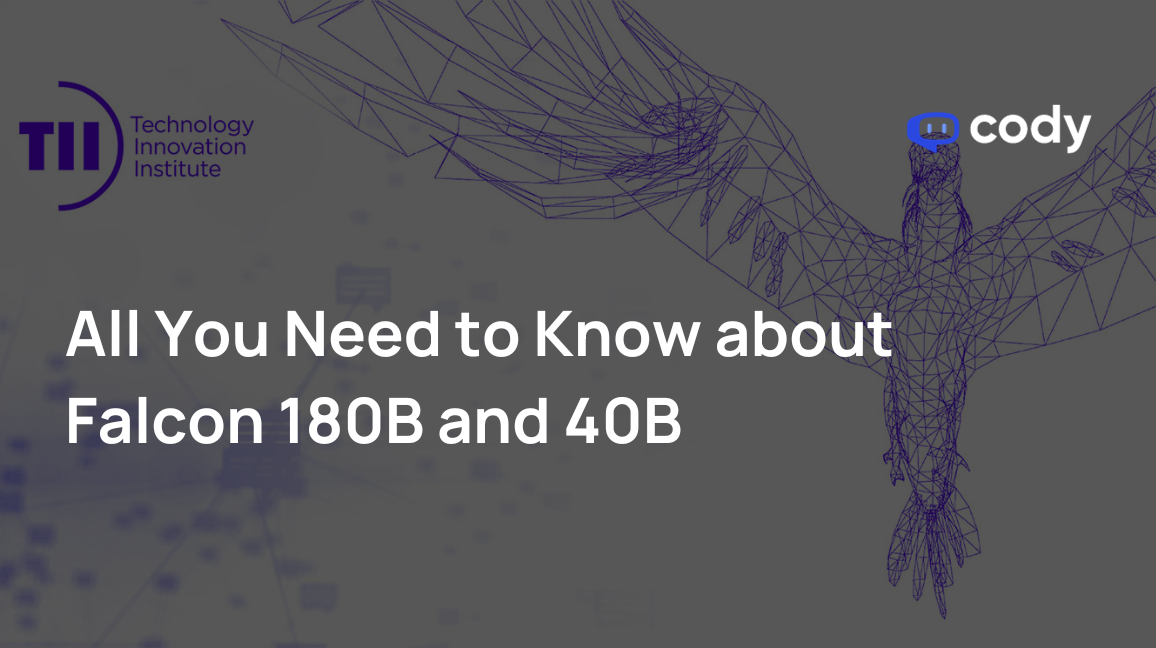
Falcon LLM distinguishes itself not just by its technical prowess but also by its open-source nature, making advanced AI capabilities accessible to a broader audience. It offers a suite of models, including the Falcon 180B, 40B, 7.5B, and 1.3B. Each model is tailored for different computational capabilities and use cases.
The 180B model, for instance, is the largest and most powerful, suitable for complex tasks, while the 1.3B model offers a more accessible option for less demanding applications.
The open-source nature of Falcon LLM, particularly its 7B and 40B models, breaks down barriers to AI technology access. This approach fosters a more inclusive AI ecosystem where individuals and organizations can deploy these models in their own environments, encouraging innovation and diversity in AI applications.
Holy Falcon! 🤯
A 7B Falcon LLM is running on M1 Mac with CoreML at 4+ tokens/sec. That’s it. pic.twitter.com/9lmigrQIiY
— Itamar Golan 🤓 (@ItakGol) June 3, 2023
What is Falcon 40B?
Falcon 40B is a part of the Falcon Large Language Model (LLM) suite, specifically designed to bridge the gap between high computational efficiency and advanced AI capabilities. It is a generative AI model with 40 billion parameters, offering a balance of performance and resource requirements.
Introducing Falcon-40B! 🚀
Sitting at the top of Open-LLM leaderboard, Falcon-40B has outperformed LLaMA, SableLM, MPT, etc.
Available in the HuggingFace ecosystem, it’s super easy to use it! 🚀
Check this out 👇 pic.twitter.com/YyXpXvNKKC
— Akshay 🚀 (@akshay_pachaar) May 28, 2023
What Can the Falcon LLM 40B Do?
Falcon 40B is capable of a wide range of tasks, including creative content generation, complex problem solving, customer service operations, virtual assistance, language translation, and sentiment analysis.
This model is particularly noteworthy for its ability to automate repetitive tasks and enhance efficiency in various industries. Falcon 40B, being open-source, provides a significant advantage in terms of accessibility and innovation, allowing it to be freely used and modified for commercial purposes.
How Was Falcon 40B Developed and Trained?
Trained on the massive 1 trillion token REFINEDWEB dataset, Falcon 40 B’s development involved extensive use of GPUs and sophisticated data processing. Falcon 40B underwent its training process on AWS SageMaker using 384 A100 40GB GPUs, employing a 3D parallelism approach that combined Tensor Parallelism (TP=8), Pipeline Parallelism (PP=4), and Data Parallelism (DP=12) alongside ZeRO. This training phase began in December 2022 and was completed over two months.
This training has equipped the model with an exceptional understanding of language and context, setting a new standard in the field of natural language processing.
The architectural design of Falcon 40B is based on GPT -3’s framework, but it incorporates significant alterations to boost its performance. This model utilizes rotary positional embeddings to improve its grasp of sequence contexts.
Its attention mechanisms are augmented with multi-query attention and FlashAttention for enriched processing. In the decoder block, Falcon 40B integrates parallel attention and Multi-Layer Perceptron (MLP) configurations, employing a dual-layer normalization approach to maintain a balance between computational efficiency and effectiveness.
What is Falcon 180B?
Falcon 180B represents the pinnacle of the Falcon LLM suite, boasting an impressive 180 billion parameters. This causal decoder-only model is trained on a massive 3.5 trillion tokens of RefinedWeb, making it one of the most advanced open-source LLMs available. It was built by TII.
It excels in a wide array of natural language processing tasks, offering unparalleled capabilities in reasoning, coding, proficiency, and knowledge tests.
Its training on the extensive RefinedWeb dataset, which includes a diverse range of data sources such as research papers, legal texts, news, literature, and social media conversations, ensures its proficiency in various applications.
Falcon 180 B’s release is a significant milestone in AI development, showcasing remarkable performance in multi-task language understanding and benchmark tests, rivaling and even surpassing other leading proprietary models.
How Does Falcon 180B Work?
As an advanced iteration of TII’s Falcon 40B model, the Falcon 180B model functions as an auto-regressive language model with an optimized transformer architecture.
Trained on an extensive 3.5 trillion data tokens, this model includes web data sourced from RefinedWeb and Amazon SageMaker.
Falcon 180B integrates a custom distributed training framework called Gigatron, which employs 3D parallelism with ZeRO optimization and custom Trion kernels. The development of this technology was resource-intensive, utilizing up to 4096 GPUs for a total of 7 million GPU hours. This extensive training makes Falcon 180B approximately 2.5 times larger than its counterparts like Llama 2.
Two distinct versions of Falcon 180B are available: the standard 180B model and 180B-Chat. The former is a pre-trained model, offering flexibility for companies to fine-tune it for specific applications. The latter, 180B-Chat, is optimized for general instructions and has been fine-tuned on instructional and conversational datasets, making it suitable for assistant-style tasks.
How is Falcon 180B’s Performance?
In terms of performance, Falcon 180B has solidified the UAE’s standing in the AI industry by delivering top-notch results and outperforming many existing solutions.
It has achieved high scores on the Hugging Face leaderboard and competes closely with proprietary models like Google’s PaLM-2. Despite being slightly behind GPT-4, Falcon 180 B’s extensive training on a vast text corpus enables exceptional language understanding and proficiency in various language tasks, potentially revolutionizing Gen-AI bot training.
What sets Falcon 180B apart is its open architecture, providing access to a model with a vast parameter set, thus empowering research and exploration in language processing. This capability presents numerous opportunities across sectors like healthcare, finance, and education.
How to Access Falcon 180B?
Access to Falcon 180B is available through HuggingFace and the TII website, including the experimental preview of the chat version. AWS also offers access via the Amazon SageMaker JumpStart service, simplifying the deployment of the model for business users.
Falcon 40B vs 180B: What’s the Difference?
The Falcon-40B pre-trained and instruct models are available under the Apache 2.0 software license, whereas the Falcon-180B pre-trained and chat models are available under the TII license. Here are 4 other key differences between Falcon 40B and 180B:
1. Model Size and Complexity
Falcon 40B has 40 billion parameters, making it a powerful yet more manageable model in terms of computational resources. Falcon 180B, on the other hand, is a much larger model with 180 billion parameters, offering enhanced capabilities and complexity.
2. Training and Data Utilization
Falcon 40B is trained on 1 trillion tokens, providing it with a broad understanding of language and context. Falcon 180B surpasses this with training on 3.5 trillion tokens, resulting in a more nuanced and sophisticated language model.
3. Applications and Use Cases
Falcon 40B is suitable for a wide range of general-purpose applications, including content generation, customer service, and language translation. Falcon 180B is more adept at handling complex tasks requiring deeper reasoning and understanding, making it ideal for advanced research and development projects.
4. Resource Requirements
Falcon 40B requires less computational power to run, making it accessible to a wider range of users and systems. Falcon 180B, due to its size and complexity, demands significantly more computational resources, targeting high-end applications and research environments.
Read More: The Commercial Usability, Open-Source Technology, and Future of Falcon LLM
F-FAQ (Falcon’s Frequently Asked Questions)
1. What Sets Falcon LLM Apart from Other Large Language Models?
Falcon LLM, particularly its Falcon 180B and 40B models, stands out due to its open-source nature and impressive scale. Falcon 180B, with 180 billion parameters, is one of the largest open-source models available, trained on a staggering 3.5 trillion tokens. This extensive training allows for exceptional language understanding and versatility in applications. Additionally, Falcon LLM’s use of innovative technologies like multi-query attention and custom Trion kernels in its architecture enhances its efficiency and effectiveness.
2. How Does Falcon 40B’s Multi-Query Attention Mechanism Work?
Falcon 40B employs a unique Multi-Query Attention mechanism, where a single key and value pair is used across all attention heads, differing from traditional multi-head attention schemes. This approach improves the model’s scalability during inference without significantly impacting the pretraining process, enhancing the model’s overall performance and efficiency.
3. What Are the Main Applications of Falcon 40B and 180B?
Falcon 40B is versatile and suitable for various tasks including content generation, customer service, and language translation. Falcon 180B, being more advanced, excels in complex tasks that require deep reasoning, such as advanced research, coding, proficiency assessments, and knowledge testing. Its extensive training on diverse data sets also makes it a powerful tool for Gen-AI bot training.
4. Can Falcon LLM Be Customized for Specific Use Cases?
Yes, one of the key advantages of Falcon LLM is its open-source nature, allowing users to customize and fine-tune the models for specific applications. The Falcon 180B model, for instance, comes in two versions: a standard pre-trained model and a chat-optimized version, each catering to different requirements. This flexibility enables organizations to adapt the model to their unique needs.
5. What Are the Computational Requirements for Running Falcon LLM Models?
Running Falcon LLM models, especially the larger variants like Falcon 180B, requires substantial computational resources. For instance, Falcon 180B needs about 640GB of memory for inference, and its large size makes it challenging to run on standard computing systems. This high demand for resources should be considered when planning to use the model, particularly for continuous operations.
6. How Does Falcon LLM Contribute to AI Research and Development?
Falcon LLM’s open-source framework significantly contributes to AI research and development by providing a platform for global collaboration and innovation. Researchers and developers can contribute to and refine the model, leading to rapid advancements in AI. This collaborative approach ensures that Falcon LLM remains at the forefront of AI technology, adapting to evolving needs and challenges.
7. Who Will Win Between Falcon LLM and LLaMA?
In this comparison, Falcon emerges as the more advantageous model. Falcon’s smaller size makes it less computationally intensive to train and utilize, an important consideration for those seeking efficient AI solutions. It excels in tasks like text generation, language translation, and a wide array of creative content creation, demonstrating a high degree of versatility and proficiency. Additionally, Falcon’s ability to assist in coding tasks further extends its utility in various technological applications.
Remember LLaMA-2?
It was the best open-source LLM for the last month.
NOT ANYMORE!
Welcome Falcon-180B!
I’ve run a comparison
GPT-4 vs. Falcon-180B
The results are unexpected!
(Bookmark for future reference)
➤ Falcon sounds less robotic
ChatGPT’s default writing style… pic.twitter.com/OqdcIvEBMe
— Luke Skyward (@Olearningcurve) September 8, 2023
On the other hand, LLaMA, while a formidable model in its own right, faces certain limitations in this comparison. Its larger size translates to greater computational expense in both training and usage, which can be a significant factor for users with limited resources. In terms of performance, LLaMA does not quite match Falcon’s efficiency in generating text, translating languages, and creating diverse types of creative content. Moreover, its capabilities do not extend to coding tasks, which restricts its applicability in scenarios where programming-related assistance is required.
While both Falcon and LLaMA are impressive in their respective domains, Falcon’s smaller, more efficient design, coupled with its broader range of capabilities, including coding, gives it an edge in this comparison.


